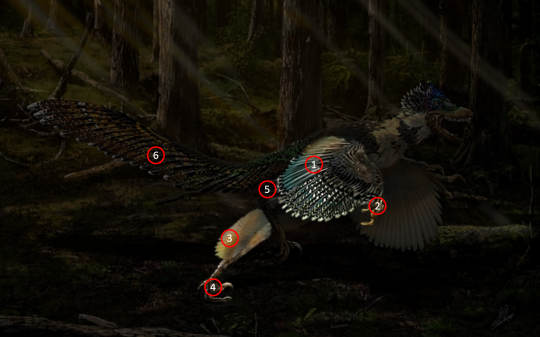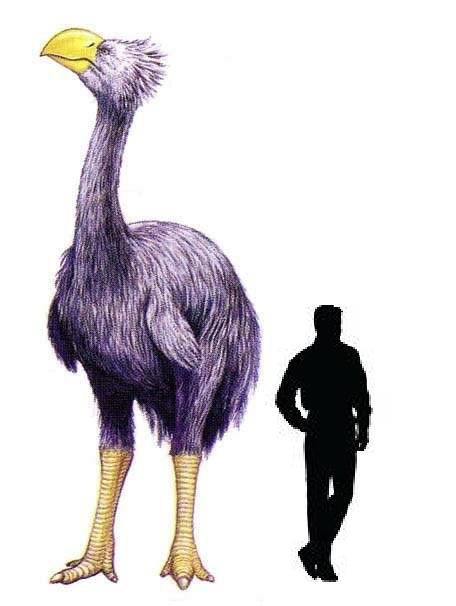Subject: Neat discovery, but...
Author:
Posted on: 2015-07-20 20:32:00 UTC
...in my honest opinion, the restoration pictured below is, uhm, disappointing:
I mean, sure, there isn't any denying that Zhenyuanlong has feathers, but my main issue is the way the plumage is depicted, among a few other things. To explain, here's a dissection of the above picture, as taken from this Tumblr post on the matter:
The list of issues pointed out by the source post are as follows, in quote:
1.) Wing Structure. Whilst Zhenyuanlong had a complicated arrangement of primaries, secondaries, coverts, and retrices, here the feathers on the arm are represented as a simple fan.
2.) Pronation. Even though this isn’t Jurassic Park Velociraptor-like full on bendy wrist pronation, this posture is still unlikely and will cause wrist breakage.
3.) Leg Feathers. Here Zhenyuanlong is depicted with vestigial Microraptor-like hindlimb feathers, whereas the actual fossil lacks any feathers around the hindlimbs. This may be a taphonomic artifact, but speculation isn’t a good way to go for a reconstruction.
4.) Shrinkwrapping. It may be a matter of texturing, but the feet of Zhenyuanlong are horrendously wrinkled in this reconstruction. This is not that major a problem for the rest of the body.
5.) Posture. The right leg is bent at a crude, almost painful angle. This certainly calls into question how the hips of this thing even work.
6.) Coloration. Having this flashy coloration may not necessarily be the best choice for an active predator. On the other hand, this may be intended to be for display. In either case, however, the colour is not what we would expect for this animal.
To add to some specific points, and in concurrence to all of them:
* Like modern birds, deinonychosaurs had primary feathers attached to the second finger (look at the fossil of Microraptor, for example). Either the artist behind the restoration did not research the fossil find or I need new glasses, because I don't see any primaries on the second finger. The primaries are now common knowledge for a significant number of palaeo-artists on the Internet, as this comic wittily demonstrates. More seriously, the notion of large primary wing feathers and their supposed interference with forelimb function is discussed in depth here.
* Apparently, the shrink-wrapping as described in the Tumblr post applies only to the feet; in modern birds, the foot musculature is pretty minimal (I had fried chicken feet in Indonesia once, and they didn't have that much meat on them). I did notice that there isn't much padding in the right foot, however, so maybe that's why the feet look so awkward. A Dr. Scholl's sole cushion would've likely been necessary for a ground-dweller to support its weight, like in the feet of ostriches, for example.
* Regarding the feather colors: I think the paleo-art circles have an inside-joke term for color schemes like this: Sparkleraptors. From what I've heard, it's often garishly colored dinos like these that turn people off from the notion of feathered dinosaurs in the first place. As noted, it's also not a new thing, either - Archaeopteryx is always depicted as being colored like a tropical bird in old dinosaur books (which is especially jarring when all the other dinosaurs are elephant-gray, mud-brown, moss-green, etc.). Most meat-eating dinosaurs would likely go with more subdued color schemes as in modern predatory mammals, and vivid colors like a bird of paradise would probably be a seasonal thing for the sake of showing off to mates and such. For the technically minded, here's a detailed explanation on dinosaur feather colors, which should be helpful for portraying plausible color schemes for at least the feathered ones. (Note that Ripper's blood-red plumage is actually quite reasonable according to the article, since carnivores like him have only structural colors and melanin to work with.)
All that being said, the artwork itself is gorgeous once you get past the technical flaws (though I had to struggle to do that, being the palaeo-nerd I am). JP notwithstanding of course, feathered dinosaurs NEED to be a thing in modern prehistory media. And to those who say feathered dinos look stupid, go anger a goose and then we'll talk. XD




